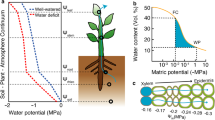Abstract
The characteristics of the water regime of spring soft wheat varieties of different ecological groups depending on water availability conditions are revealed. It is established that, under arid conditions, varieties of the Volga steppe and West Siberian forest-steppe ecotypes have more stable dynamics of total water content of plant tissues, less depression of transpiration, high water-retaining capacity, and comparatively low water consumption coefficients. The results of the investigations can be used when selecting parent forms for breeding spring wheat under the forest-steppe conditions of the Orenburg Cis-Ural region.
Similar content being viewed by others
References
Udovenko, G.V., Mechanisms of Adaptation of Plants to Stresses, Fiziol. Biokhim. Kul’t. Rast., 1979, vol. 11,no. 2.
Kumakov, V.A., Fiziologiya yarovoi pshenitsy (Physiology of Spring Wheat), Moscow: Kolos, 1980.
Samuilov, F.D., Vodnyi obmen i sostoyanie vody v rasteniyakh (Water Exchange and State of Water in Plants), Kazan: Izd. KGU, 1972.
Shmat’ko, I.G. and Shvedova, O.E., Vodnyi rezhime i zasukhoustoichivost’ pshenitsy (Water Regime and Drought Resistance of Wheat), Kiev: Naukova Dumka, 1977.
Tret’yakov, N.N., Karnaukhova, T.V., Panichkin, L.A., et al., Praktikum po fiziologii rastenii (Practicum on Plant Physiology), Moscow: Agropromizdat, 1990.
Nekotorye priemy i metody fiziologicheskogo izucheniya sortov zernovykh kul’tur v polevykh usloviyakh (Some Procedures and Methods for Physiological Study of Cereal Varieties under Field Conditions), Kumakov, V.A. (Ed.), Saratov: NIISKh Yugo-Vostoka, 2000.
Suleimanov, I.G., Sostoyanie i rol’ vody v rastenii (State and Role of Water in Plants), Kazan: Izd. KGU, 1974.
Kostyakov, A.N., Osnovy melioratsii (Principles of Amelioration), Moscow: Sel’khozgiz, 1960.
Samuilov, F.D. and Mukhitov, L.A., Water Regime and Productivity in Relation to Meteorological Conditions in the Forest Steppe of Orenburg Cis-Ural Region, Biologicheskie i tekhnologicheskie aspekty povysheniya Urozhainost sel’skokhozyaistvennykh kul’tur (Biological and Technological Aspects of Increasing the Yielding Ability of Crops), Kazan, 1997.
Kozhushko, N.N., Water-Retaining Capacity as an Index of Drought Resistance of Plants, Fiziologiya ustoichivosti kul’turnykh rastenii (Physiological Resistance of Crop Plants), Leningrad: VIR, 1976.
Zyalalov, A.A., Vodyi obmen sel’skokhozyaistvennykh rastenii (Water Exchange of Crop Plants), Kazan, 1983.
Author information
Authors and Affiliations
Corresponding author
Additional information
Original Russian Text © F.D. Samuilov, L.A. Mukhitov, 2012, published in Doklady Rossiiskoi Akademii Sel’skokhozyaistvennykh Nauk, 2012, No. 5, pp. 10–13.
About this article
Cite this article
Samuilov, F.D., Mukhitov, L.A. Water regime and water consumption of spring soft wheat varieties of different ecological groups under contrasting water availability conditions. Russ. Agricult. Sci. 38, 353–357 (2012). https://doi.org/10.3103/S1068367412050151
Received:
Published:
Issue Date:
DOI: https://doi.org/10.3103/S1068367412050151




